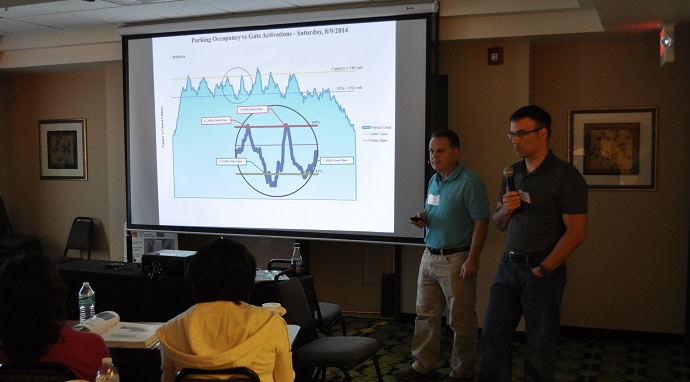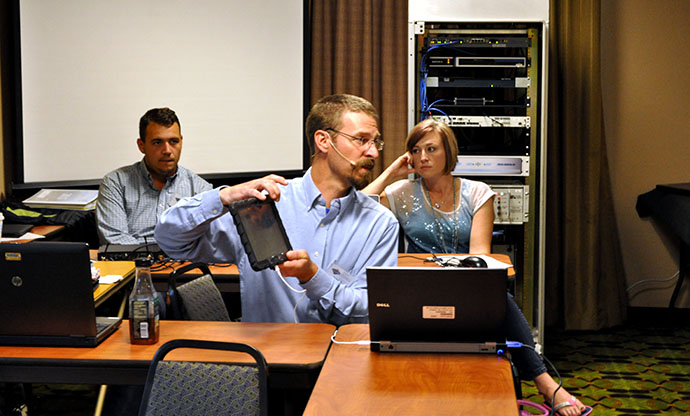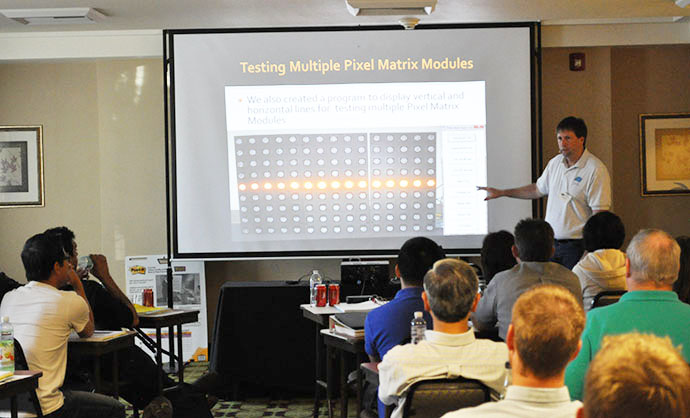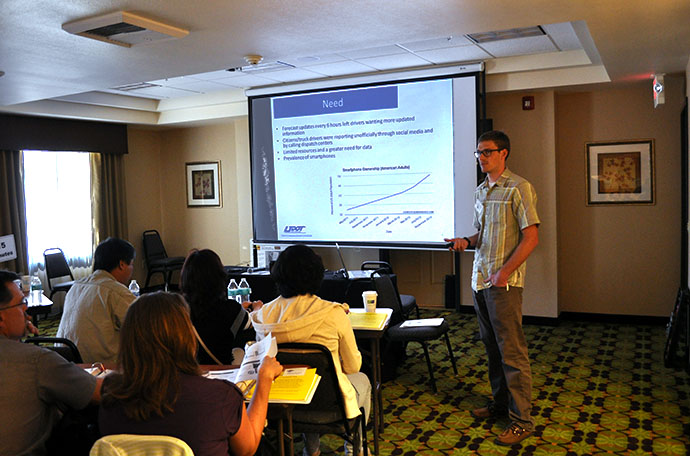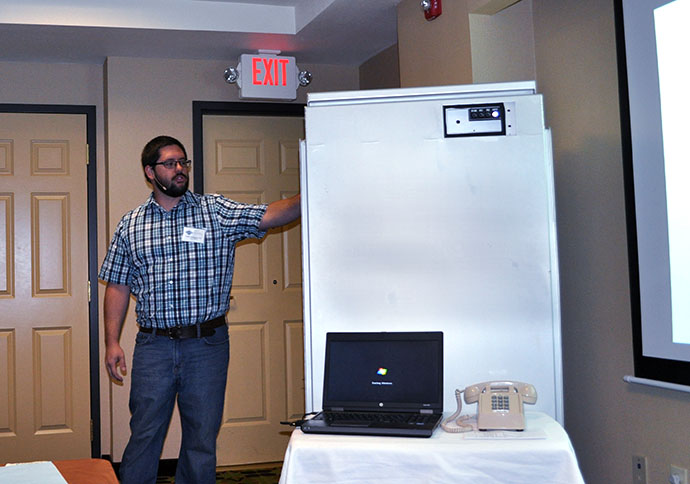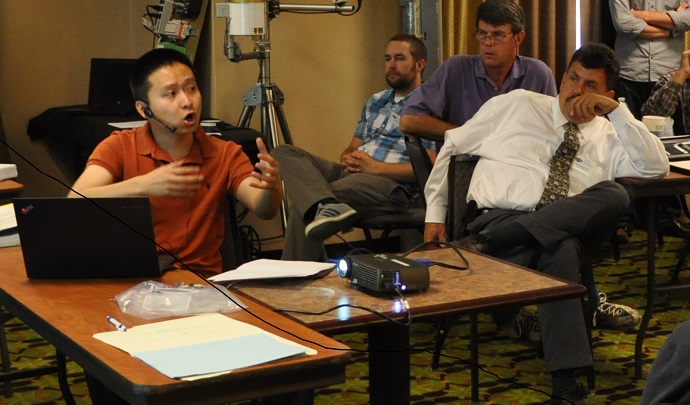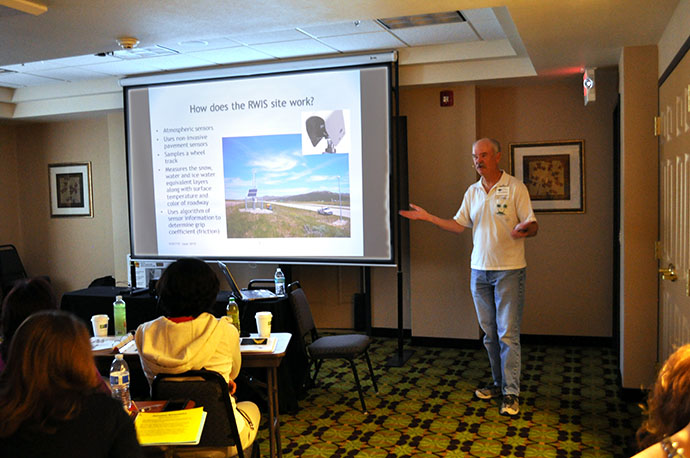2015
Western States Rural Transportation Technology Implementers Forum
June 16th-18th, Yreka, California

SCHEDULE OF EVENTS
Tuesday, June 16, 2015
4:00 pm to 7:00 pm Registration
5:00 pm to 6:30 pm Reception (no-host)
6:30 pm to 9:00 pm Dinner
Wednesday, June 17, 2015
7:00 am to 8:00 am Breakfast
8:00 am to 11:40 am Welcome and Presentations
11:40 am to 12:45 pm Lunch
12:45 pm to 5:15 pm Technical Presentations, Evaluations,
Remarks
6:00 pm to 9:00 pm Dinner and Networking Session
Thursday, June 18, 2015
7:00 am to 8:00 am Breakfast
8:00 am to 12:15 pm Technical Presentations
12:15 pm to 1:15 pm Lunch, Evaluations, Remarks
PRESENTATIONS AND DEMONSTRATIONS*
Multnomah Falls Parking Management System
Dennis Mitchell, Doug Spencer
Oregon DOT
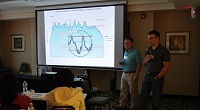
|
|
Multnomah Falls is the second highest year-round
waterfall in the United States and is located in the
Columbia River Gorge National Scenic Area,
approximately 30 miles east of Portland. The falls
attract approximately two million visitors each
year. Due to the popularity of the falls,
especially during the summer months, demand often
exceeds available parking at the two primary parking
lots. One of these parking lots is located in a
center median of Interstate 84. When this parking
lot approaches capacity, queueing can occur along
the I-84 eastbound exit ramp (entrance to the
parking lot). This queueing has led to several
incidents and has required ODOT maintenance crews to
manually close the exit ramp under these conditions.
The safety concerns associated with this parking
issue have led ODOT to develop an automated parking
system for Multnomah Falls, capable of detecting lot
occupancy thresholds, notifying travelers of lot
closure, and barricading the off-ramp. Dennis
Mitchell and Doug Spencer, Oregon DOT ITS Engineers,
discussed the design of the system including
signage, detection, gate systems, ITS hardware and
software, and the operational observations (as well
as resulting improvements) of the system made to
date.
|
The Nevada Data Exchange (NDEX): An Internet Portal for
Public and Strategic Partners to Publish Their Data and
Subscribe to NDOT’s Traveler Information
Israel Lopez
Nevada DOT
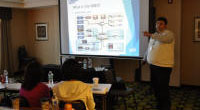
|
|
Israel Lopez from Nevada DOT’s Traffic Operations
Technology Section presented the Nevada Data
Exchange (NDEX). The NDEX uses the Traffic
Management Data Dictionary (TMDD) standard to create
a data exchange to aggregate the States’ data,
create a data archive for historical data queries,
and create an effective visualization dashboard to
display current metrics / key performance indicators
(KPIs). Mr. Lopez explained the problem and need
for the project along with the resulting technical
needs and requirements. He also described the
purpose and functionality of the NDEX in relation to
various NDOT data sources such as RWIS, CCTV, DMS,
and HAR, and discussed the soon to be released data
visualization module.
|
WYDOT Roadside WiFi and Tablet App
Mark Kelly
Wyoming DOT
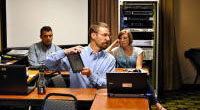
|
|
In an effort to improve information management
during weather events and post road conditions more
quickly on the WYOROAD website, Wyoming DOT
developed a tablet reporting app for use by
maintenance personnel (i.e., snow plows, foreman
trucks). At the same time, WYDOT also installed
WiFi hotspots at various locations to complement
Wyoming’s statewide low speed “P25 data”
communications network. Prior to this system, plow
drivers across the state reported road conditions
and incidents, and requested speed limit (VSL) and
Dynamic Message Sign (DMS) changes, pace speeds, and
wind speeds via radio from the WYDOT Transportation
Management Center (TMC) dispatcher. The dispatcher
would then record/give requested information,
transfer information to Wyoming Highway Patrol (WHP)
and then the information could be posted to the web
site and other information systems for the public.
The in-vehicle app and Wi-Fi system significantly
streamlines the gathering of information from WYDOT
personnel and posting to the WYOROAD website,
improves timeliness and accuracy of condition
reports, and provides more information to
maintenance personnel. Mark Kelly, Communications
Systems Supervisor for WYDOT, explained the need and
goals for the tablet app and reviewed its
development. He discussed the functionality of the
app and then gave a live demonstration of the
system. Mr. Kelly also discussed the WyoLink P25
radio system and the new WiFi installations that the
tablet uses to communicate with the TMC.
|
Advanced
Variable Message Sign
David Wells
Caltrans Headquarters
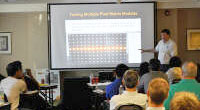
|
|
Faced with the need for hundreds more variable
message signs (VMS), Caltrans considered advantages
and disadvantages of different procurement options
before choosing to develop and build its own
advanced VMS. David Wells, Caltrans Senior
Transportation Electrical Engineer and AVMS Project
Manager, discussed the development of the AVMS
specification, and the design, manufacturing, and
testing of the new sign and its control software.
He reviewed the various off-the-shelf components of
the sign as well as the custom Pixel Matrix Modules,
the Remote I/O Box, and the Test Box. Along with
the design advantages of the new sign, Mr. Wells
also described the features and benefits of the
improved custom sign control software. The Caltrans
AVMS is non-proprietary, has interchangeable parts
between manufacturers, provides a color option, uses
less power and a safer low voltage design, and has
improved operating capabilities. Mr. Wells
demonstrated several of the Pixel Matrix Modules
during breaks and networking sessions.
|
Utah Department of Transportation (UDOT) Citizen Reporting
Program
Corey Coulam, Lisa Miller
Utah DOT
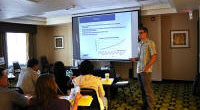
|
|
The Utah Citizen Reporter Program enlists trained
volunteers to report road conditions along specific
roadway segments across Utah. The long term goal of
adding Citizen Reporters to UDOT’s weather
operations road reporting is to supplement current
condition reporting on segments where drivers are
already traveling. Many of the segments selected for
the program are critical rural routes where there is
no infrastructure to install traffic cameras or an
RWIS. The citizen reporters are intended to enhance
UDOT’s coverage of road weather reporting on
under-reported segments throughout the state of
Utah. Citizen Reporters submit their observations
through an industry-first reporting app. Corey
Coulam, a program manager for the Utah Traffic
Operations Center, presented the need for the
program, the program’s goals, technical and
ideological structure and integration with Utah’s
traveler information system, and participation
statistics.
|
Safety Chain Control System
Keith Koeppen
Caltrans District 2
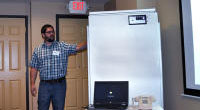
|
|
Winter operations can be dangerous due to low
visibility, severe weather, and icy roadway
conditions. This is further compounded when chain
conditions exist and field maintenance workers are
on foot near live traffic. This is the case along
Interstate 5 in Yreka, California, where signs that
display current chain conditions to the motoring
public are routinely changed during storms.
Traditionally, field maintenance workers must
traverse the freeway several times whenever a chain
control condition changes. This exposes workers to
oncoming traffic in snowy and icy roadway
conditions. ITS engineer Keith Koeppen, of Caltrans
District 2, discussed and demonstrated the Safety
Chain Control System that he and his project team
developed to enhance worker safety in these
conditions. The new system is semi-automated and
allows field maintenance workers to activate the
chain condition signs remotely from a cell phone or
traffic cabinet. Mr. Koeppen explained the
technical architecture of the system, described the
system’s details, and discussed the deployment of
the system and associated challenges.
|
TranSync
Mobile Tool (Traffic Signal Management and Retiming Tool) Pilot
Project in Auburn and San Francisco Bay Area (Caltrans Districts
3 and 4): Improving Signal Timing and Coordination
Martha Styer, Dali Wei
Caltrans Headquarters
Note: PDF contains embedded video clips and is ~31 MB in
size. Adobe Reader 9 or higher is needed to view these video
clips. A version without embedded video (~4.2 MB) is available
here.
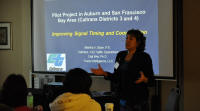

|
|
Martha Styer, a Senior Transportation Electrical
Engineer for Caltrans Division of Traffic
Operations, and Dr. Dali Wei, a post doc researcher
at UC Davis and software developer for Trans
Intelligence, presented and demonstrated the
TranSync Mobile Tool. The tool was developed by
Trans Intelligence to provide an easy to use app for
signal timing diagnosis, traffic progression
evaluation, traffic signal timing verification, and
bandwidth optimization functions. Instead of using
personnel observation of traffic, TranSync is a
useful tool for signal operations engineers to
verify and quantify signal timing improvements, in
real-time. Ms. Styer reviewed the basics of signal
timing and the current practices for optimization,
as well as how the TranSync tool could improve upon
the current techniques. Dr. Wei demonstrated the
app and discussed the results of case studies
completed in Auburn, Yuba City, and Mountain View,
California.
|
Idaho
Transportation Department Winter Performance Measures
Robert Koeberlein, Dennis Jensen
Idaho Transportation Department
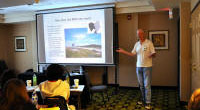
|
|
At the 2013 Forum, Dennis Jensen presented Idaho’s
Winter Performance Measures program. Since that
time significant development and research have taken
place, and the program has evolved. This year, Bob
Koeberlein, Headquarters Operations Engineer for the
Idaho Transportation Department, provided an update
on the Winter Performance Measures program and the
latest results of the program’s implementation. He
reviewed the concept behind the program, the
transition from testing to full implementation, and
growth of the system. Mr. Koeberlein explained the
various calculations involved in the winter
performance measures and discussed how the system
has been implemented in terms of RWIS sensors and
“scoring” algorithms to monitor the “grip”
coefficient on Idaho’s roads during winter weather
events. He also discussed the success of the
program in regards to cost and operational benefits,
lessons learned, and next steps for the program.
|
TOP
*These presentations are posted as developed by the speakers and presented at the 2015 Forum. Alternative accessible formats of these documents can be provided upon request. Persons with disabilities who need an alternative accessible format of this information, or who require some other reasonable accommodation to participate, should contact Neil Hetherington, Visual Communications Manager, Western Transportation Institute, Montana State University, PO Box 174250, Bozeman, MT 59717-4250, telephone number 406-994-3566, e-mail: hetherington "at" montana.edu; or Dana May, Business Development Manager, Western Transportation Institute, Montana State University, PO Box 174250, Bozeman, MT 59717-4250, telephone number (406) 994-6361, e-mail: dana.may "at" montana.edu. |




